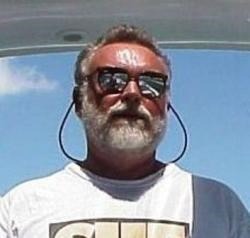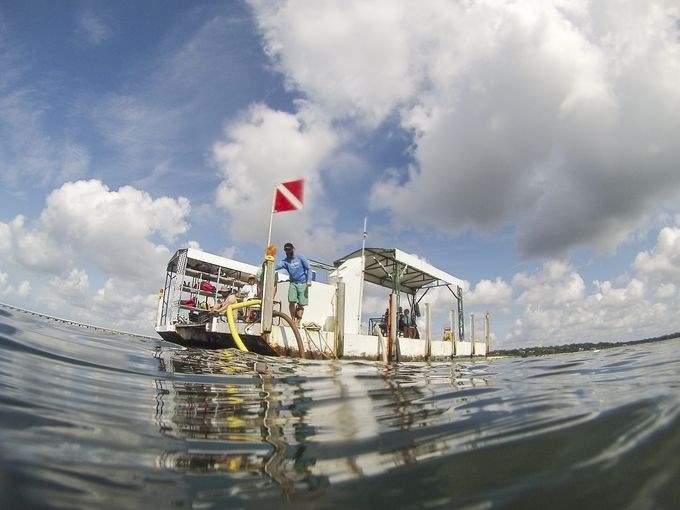The Shipwrecks of the Luna Fleet in Pensacola Bay
by Caleb Curren
Contact Archeology Inc.
Feb. 2018
Archeologist Roger Smith was on a mission. He wanted to find the hurricane-wrecked shipwrecks of the 16th-Century Spanish expedition led by Tristan de Luna located in Pensacola Bay, Florida. Other archeologists discouraged him. They said he was looking for a very tiny needle in a very large haystack and he could not even hope to find the shipwrecks of the Luna Expedition. Smith persevered. He found his Luna shipwreck despite the skeptics.
After completing technical reports and presenting papers of his shipwreck research, he passed the baton to the University of West Florida (UWF). Grants were forthcoming. Two more shipwrecks were found in the vicinity of the first shipwreck. The discoveries of Roger Smith and UWF are landmark discoveries concerning first contacts of Europeans and Native peoples. Their discoveries are being recognized for their unique research importance.
Now come the detailed questions of what the discoveries actually mean relative to the possible land colony of the Luna Expedition. The chroniclers of the Luna Expedition indicated that the anchorage of the 11-ship fleet was located adjacent to their colony site. Seemingly, the discovery of three shipwrecks of the Luna fleet just offshore of a terrestrial archeological site with abundant 16th-Century Spanish artifacts is a “no brainer.” The terrestrial site must be the site of the 1559 Spanish Luna Colony. Maybe it is … or maybe it isn’t.
The “fly in the ointment” of the shipwreck discoveries is that none of the shipwrecks have been reported as being anchored. The ships were blown onto a shallow sand shelf where they came to rest from their anchorage elsewhere in Pensacola Bay. Critically, their original anchorage has not been found. That brings into question the UWF claim of the Luna Colony land site adjacent to the shipwrecks. Hundreds of 16th-Century Spanish artifacts have been found at the known Native village site (Emanuel Point, 8Es1) but numerous Spanish structures, burials, refuse pits, or fire hearths have not been reported. That is perplexing.
At least a portion of the 1500 people of the Luna Expedition occupied the colony for over two years. They built structures, they burned fires, they buried their dead, and they left their garbage. Where are these archeological features? UWF has conducted extensive excavations at the land site without success at finding these imperative features, but the hundreds of Spanish artifacts cannot be ignored: How did they get there? Were the Native peoples salvaging the Spanish shipwrecks just offshore and bringing artifacts back to their village? Did the Natives have contact with other 16th-Century Spanish expeditions in Pensacola Bay? Is the site really the location of the Luna Colony despite the lack of features? Was the anchorage of the shipwrecks just a few hundred yards further out into the bay from the shipwrecks? If this land site is not the Luna Colony, where is it? Where is the original anchorage of the Luna fleet? To find out, more fieldwork is needed in the bay and on the land concerning this archeological mystery. Hopefully, excavations on the three shipwrecks and the alleged land site will provide definitive data concerning this important archeological conundrum.
Sample of Related Publications
Arnold, J. Barto III, and Robert Weddle
1978 The Nautical Archaeology of Padre Island. Academic Press, New York.
Arnold, J. Barto III, David R. Watson, and Donald H. Keith
1995 The Padre Island Crossbows. Historical Archaeology 29(2):4-16.
Curren, Caleb
2017a Anchorage or Grounding? Two Shipwrecks of the 1559 Luna Expedition, Pensacola Bay,
Florida. Archeology Ink: An Online Journal. http://archeologyink.com/anchorage-or-grounding/
2017b The Oldest Shipwrecks in Pensacola Bay, Florida. Archeology Ink: An Online Journal.
Scott, Della
1995 Unique Artifacts from the Emanuel Point Shipwreck. Underwater Archaeology Proceedings from the Society for Historical Archaeology Conference 1995; 60-63. Paul F. Johnston, editor.
Washington, D.C.
Smith, Roger C., John R. Bratten, J. COZ Cozzi, and Keith Plaskett
1998 The Emanuel Point Ship Archaeological Investigations, 1997-1998. Report of Investigations #68. Archaeology Institute, University of West Florida.
Smith, Roger C., James Spirek, John Bratten, and Della Scott-Ireton
1995 The Emanuel Point Ship: Archaeological Investigations, 1992-1995, Preliminary Report.
Bureau of Archaeological Research, Division of Historical Resources, Florida Department of State.
Smith, Roger C.
1993 Vanguard of Empire: Ships of Exploration in the Age of Columbus. Oxford University Press. New York and Oxford.
Spirek, James
1995 Pinned to the Bottom: Emanuel Point Hull Remains. Underwater Archaeology Proceedings from the Society for Historical Archaeology Conference 1995:43-48. Paul F. Johnson, editor. Washington, D.C.
Watts, Gordon, P. Jr.
1993 The Western Ledge Reef Wreck: A Preliminary Report on the Investigation of the remains of a 16th-Century Shipwreck in Bermuda. International Journal of Nautical Archaeology 22(2): 103-24.
Worth, John E.
2016 Preliminary Observations on the Archaeological Assemblage of the 1559-1561 Tristan de Luna Settlement. Paper presented at t49th Annual Conference of the Society for Historical
Archaeology. Washington.
- Article
-
Archeologist Roger Smith was on a mission. He wanted to find the hurricane-wrecked shipwrecks of the 16th-Century Spanish expedition led by Tristan de Luna located in Pensacola Bay, Florida. Other archeologists discouraged him. They said he was looking for a very tiny needle in a very large haystack and he could not even hope to find the shipwrecks of the Luna Expedition. Smith persevered. He found his Luna shipwreck despite the skeptics.
After completing technical reports and presenting papers of his shipwreck research, he passed the baton to the University of West Florida (UWF). Grants were forthcoming. Two more shipwrecks were found in the vicinity of the first shipwreck. The discoveries of Roger Smith and UWF are landmark discoveries concerning first contacts of Europeans and Native peoples. Their discoveries are being recognized for their unique research importance.
Now come the detailed questions of what the discoveries actually mean relative to the possible land colony of the Luna Expedition. The chroniclers of the Luna Expedition indicated that the anchorage of the 11-ship fleet was located adjacent to their colony site. Seemingly, the discovery of three shipwrecks of the Luna fleet just offshore of a terrestrial archeological site with abundant 16th-Century Spanish artifacts is a “no brainer.” The terrestrial site must be the site of the 1559 Spanish Luna Colony. Maybe it is … or maybe it isn’t.
The “fly in the ointment” of the shipwreck discoveries is that none of the shipwrecks have been reported as being anchored. The ships were blown onto a shallow sand shelf where they came to rest from their anchorage elsewhere in Pensacola Bay. Critically, their original anchorage has not been found. That brings into question the UWF claim of the Luna Colony land site adjacent to the shipwrecks. Hundreds of 16th-Century Spanish artifacts have been found at the known Native village site (Emanuel Point, 8Es1) but numerous Spanish structures, burials, refuse pits, or fire hearths have not been reported. That is perplexing.
At least a portion of the 1500 people of the Luna Expedition occupied the colony for over two years. They built structures, they burned fires, they buried their dead, and they left their garbage. Where are these archeological features? UWF has conducted extensive excavations at the land site without success at finding these imperative features, but the hundreds of Spanish artifacts cannot be ignored: How did they get there? Were the Native peoples salvaging the Spanish shipwrecks just offshore and bringing artifacts back to their village? Did the Natives have contact with other 16th-Century Spanish expeditions in Pensacola Bay? Is the site really the location of the Luna Colony despite the lack of features? Was the anchorage of the shipwrecks just a few hundred yards further out into the bay from the shipwrecks? If this land site is not the Luna Colony, where is it? Where is the original anchorage of the Luna fleet? To find out, more fieldwork is needed in the bay and on the land concerning this archeological mystery. Hopefully, excavations on the three shipwrecks and the alleged land site will provide definitive data concerning this important archeological conundrum.
- References and Related Works
-
Sample of Related Publications
Arnold, J. Barto III, and Robert Weddle
1978 The Nautical Archaeology of Padre Island. Academic Press, New York.Arnold, J. Barto III, David R. Watson, and Donald H. Keith
1995 The Padre Island Crossbows. Historical Archaeology 29(2):4-16.Curren, Caleb
2017a Anchorage or Grounding? Two Shipwrecks of the 1559 Luna Expedition, Pensacola Bay,
Florida. Archeology Ink: An Online Journal. http://archeologyink.com/anchorage-or-grounding/2017b The Oldest Shipwrecks in Pensacola Bay, Florida. Archeology Ink: An Online Journal.
Scott, Della
1995 Unique Artifacts from the Emanuel Point Shipwreck. Underwater Archaeology Proceedings from the Society for Historical Archaeology Conference 1995; 60-63. Paul F. Johnston, editor.
Washington, D.C.Smith, Roger C., John R. Bratten, J. COZ Cozzi, and Keith Plaskett
1998 The Emanuel Point Ship Archaeological Investigations, 1997-1998. Report of Investigations #68. Archaeology Institute, University of West Florida.Smith, Roger C., James Spirek, John Bratten, and Della Scott-Ireton
1995 The Emanuel Point Ship: Archaeological Investigations, 1992-1995, Preliminary Report.
Bureau of Archaeological Research, Division of Historical Resources, Florida Department of State.Smith, Roger C.
1993 Vanguard of Empire: Ships of Exploration in the Age of Columbus. Oxford University Press. New York and Oxford.Spirek, James
1995 Pinned to the Bottom: Emanuel Point Hull Remains. Underwater Archaeology Proceedings from the Society for Historical Archaeology Conference 1995:43-48. Paul F. Johnson, editor. Washington, D.C.Watts, Gordon, P. Jr.
1993 The Western Ledge Reef Wreck: A Preliminary Report on the Investigation of the remains of a 16th-Century Shipwreck in Bermuda. International Journal of Nautical Archaeology 22(2): 103-24.Worth, John E.
2016 Preliminary Observations on the Archaeological Assemblage of the 1559-1561 Tristan de Luna Settlement. Paper presented at t49th Annual Conference of the Society for Historical
Archaeology. Washington. - Download PDF Version


